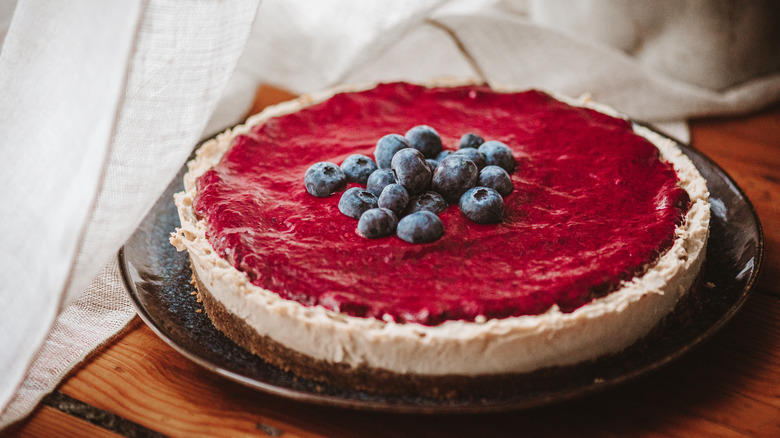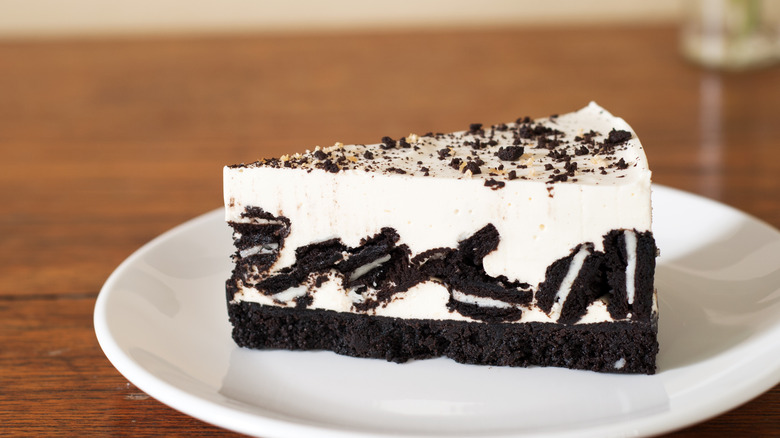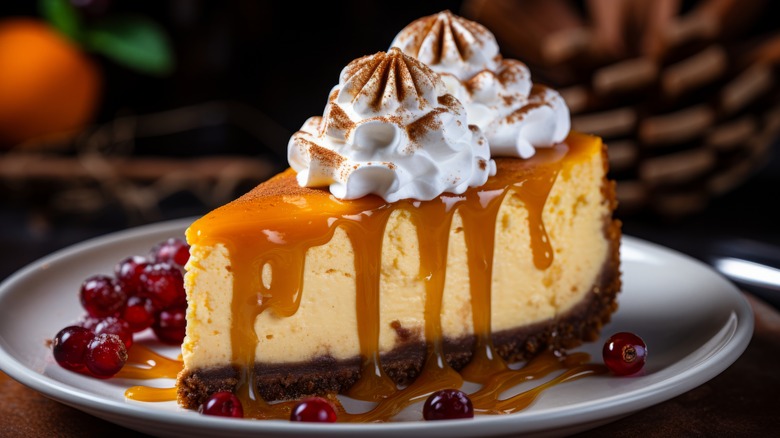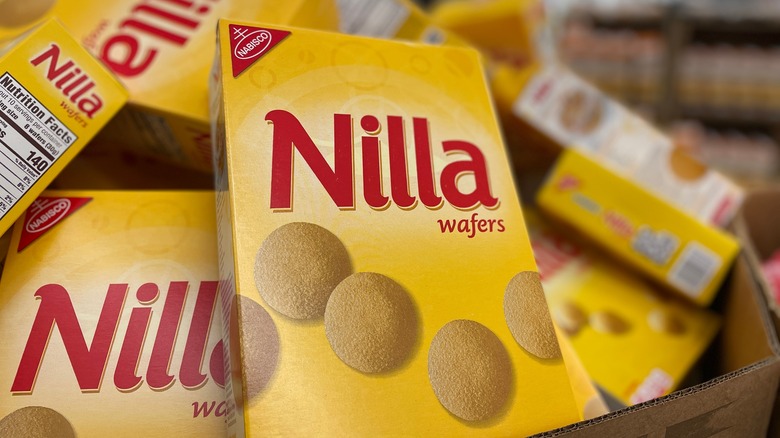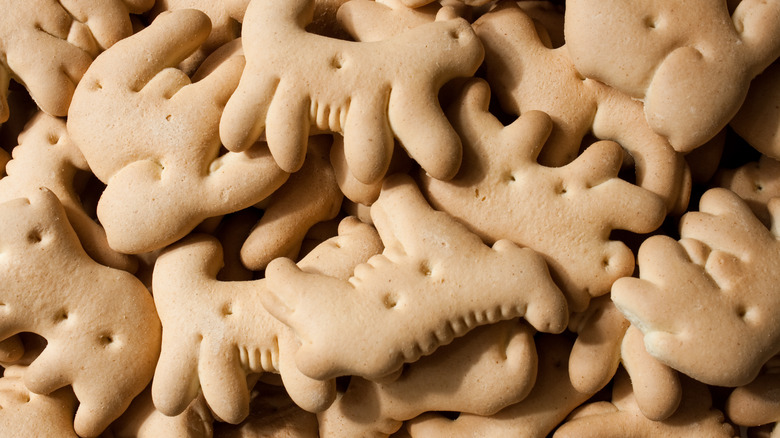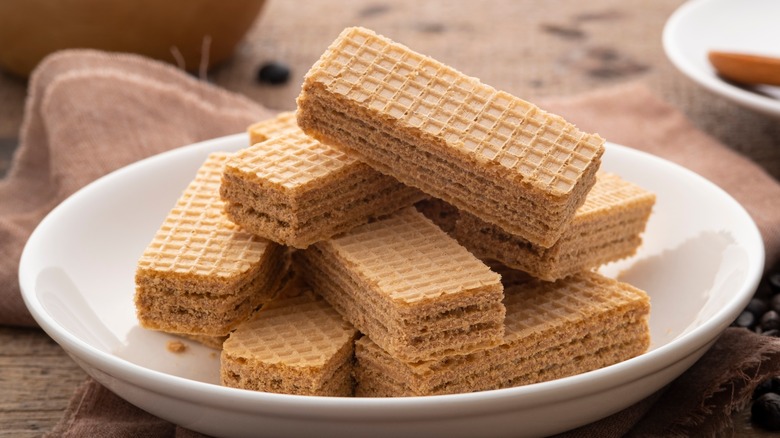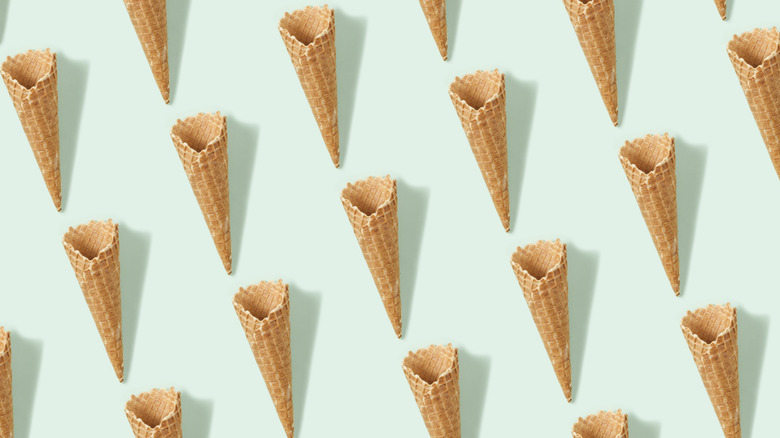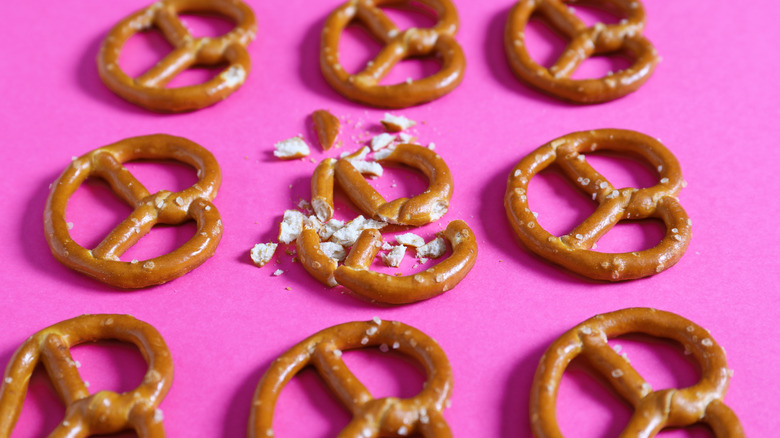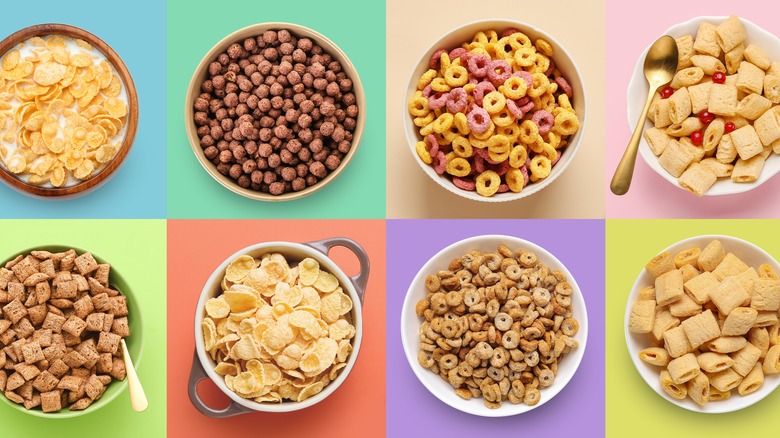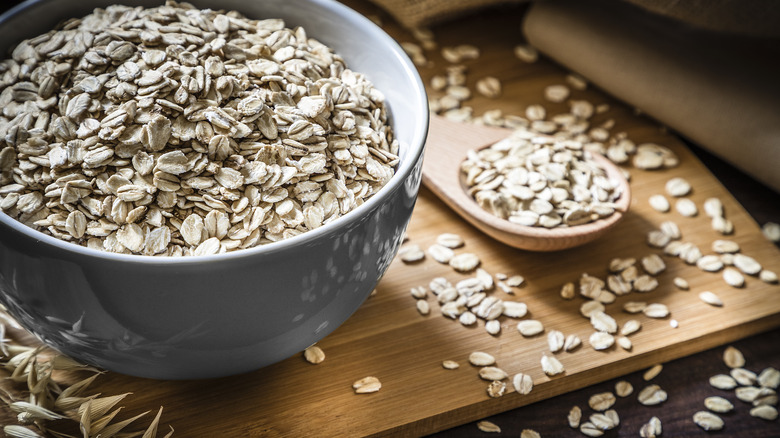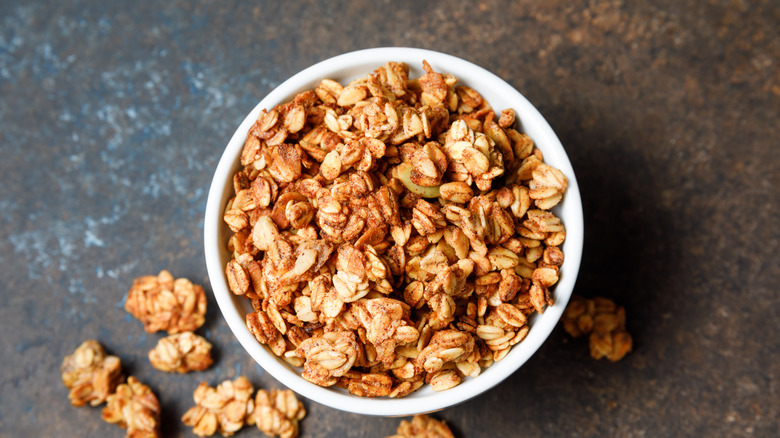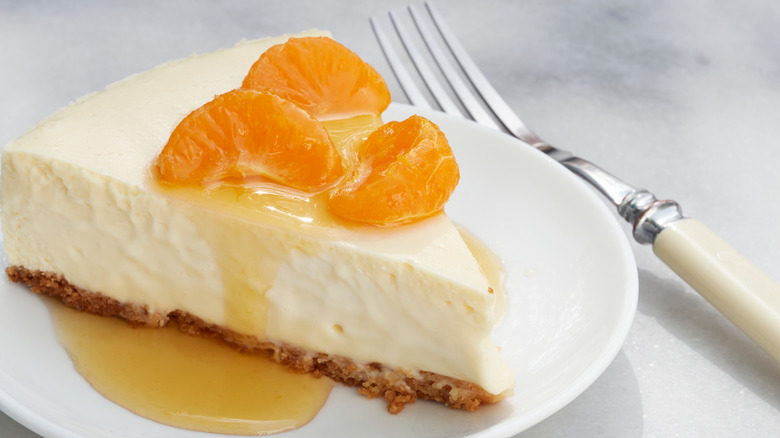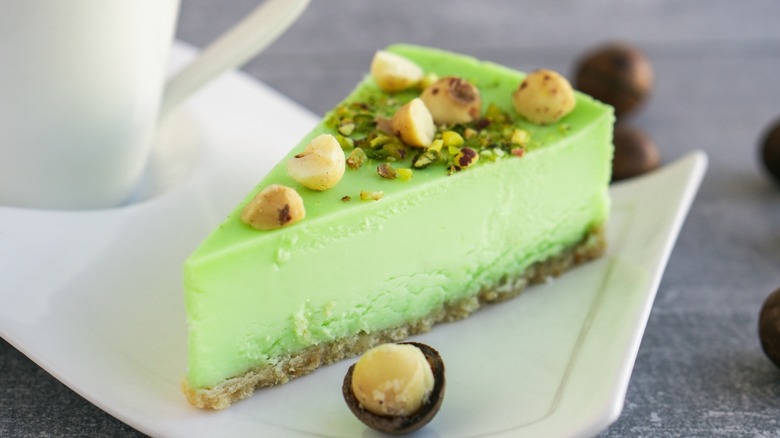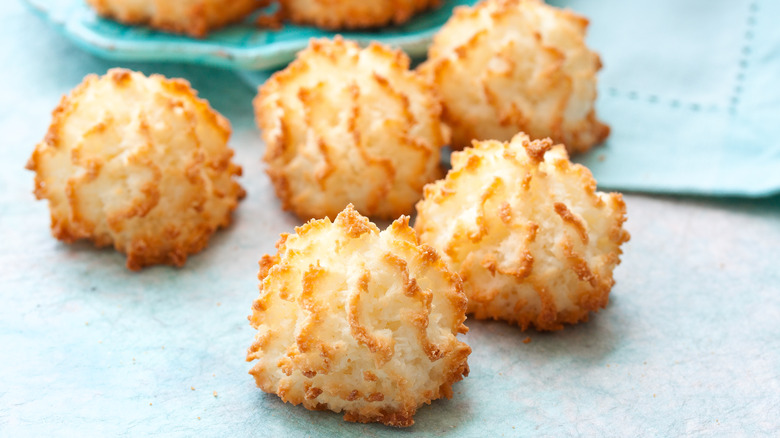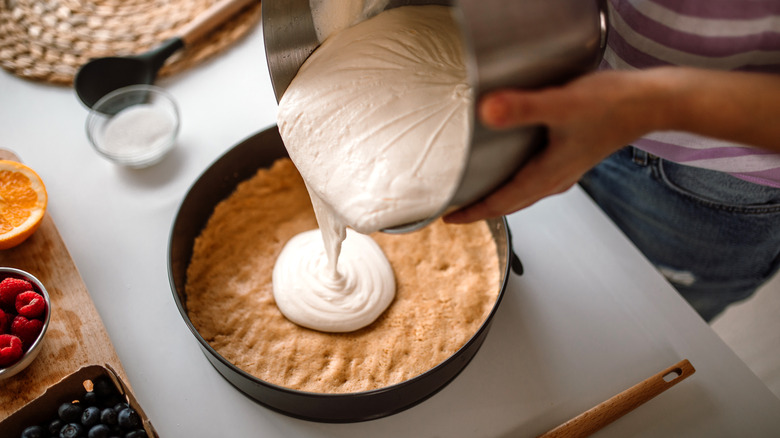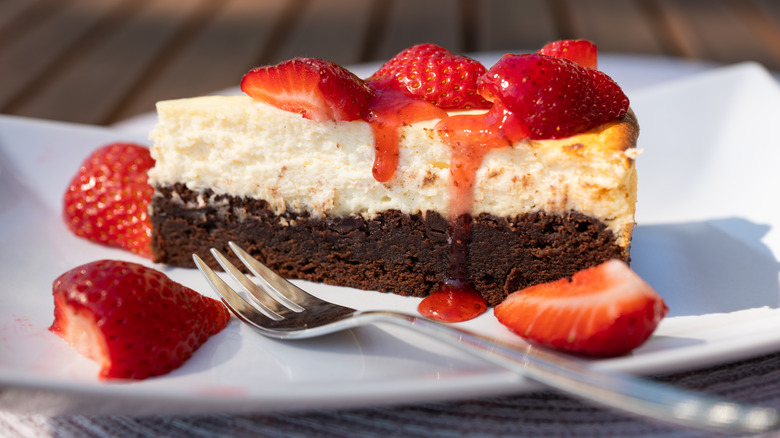Cheesecake Crust Alternatives You Haven't Thought Of
Classic American cheesecake recipes — whether they call for you to bake the cheesecake, just throw it into the fridge to set, top it with strawberries or cherries or chocolate or whatever — pretty much always call for one thing in particular: a graham cracker crust. (And before you say that real cheesecake doesn't come with a crust, consider that, for most home cooks, it does; many home cooks want to make something slightly simpler than a Basque cheesecake. Besides, who are we to argue about authenticity when the results are still delicious?)
The graham cracker crust is tasty, versatile, and easy. That said, you might not always have graham crackers on hand or enough graham crackers to make a full crust. The good news? There are lots of ingredients that you can use to make a cheesecake crust that don't involve graham crackers. In fact, you might find that some cheesecake crust alternatives are even more delicious than the classic graham cracker crust, while being just as easy to make. Here are some cheesecake crust alternatives to consider.
Crushed Oreos
Oreos are amazing as is, but there's a whole lot you can do with these hack-friendly cookies, including turning them into a pie or cheesecake crust. Just as you would when making a graham cracker crust, crush your Oreo cookies and mix them with butter, before pressing the mixture into your pie plate or springform cake pan. Whether you prefer to throw your cookies in a food processor for a pristinely even crumb, or you take out your frustration on the cookies using the ol' baggy-and-rolling-pin cookie crushing method, one step that can make your life easier is to put the Oreos in the freezer for at least a half hour before starting, so that the cream filling doesn't turn gummy as you crush the cookies.
This alternative is particularly a good fit for no-bake cheesecakes (Oreos aren't quite as oven-friendly as graham crackers), but, if you have time, let your Oreo crust firm up by putting it in the fridge to cool before adding your cheesecake filling.
Crushed gingersnaps
If you don't find that graham cracker crusts, or graham crackers in general, provide your baking projects with enough flavor (they were, after all, invented to help tamper consumers' excitement), consider swapping your graham cracker crust for a cheesecake crust made from an undeniably more flavorful option: gingersnaps. These zippy, zingy, crunchy cookies will pair especially well with a cheesecake that offers some citrus notes or, in the fall, with a pumpkin cheesecake recipe. (No springform pan on hand? These pumpkin cheesecake bars come together in a standard square baking pan.) Just sub in gingersnaps where the recipes call for graham crackers.
Home bakers on Reddit suggest using an equal mixture of crushed gingersnaps and crushed graham crackers — if the ginger flavor doesn't come through enough for you, add some extra powdered ginger — or try mixing your crushed gingersnaps with some ground pecans. Whatever option you go with, though, pick a high-quality gingersnap that will provide a lot of spice.
Crushed vanilla wafers
While some home cooks crave something a little more flavorful to replace their cheesecake's graham cracker crust, some home cooks prefer graham cracker crusts precisely because of that mild flavor. If mild's your preference, consider switching things up with the graham cracker's arguably equally mild cookie cousin, the vanilla wafer (or Nilla wafers if you're loyal to the well-known brand from Nabisco).
If you've ever made banana pudding, you already know vanilla wafers are a cookie that can stand up to moist, heavy ingredients, so it should come as no surprise that a vanilla wafer crust is a good fit for your cheesecake, too. A basic vanilla wafer crust recipe simply calls for the wafers, sugar, and melted butter or margarine. You will need to bake and cool this crust before you use it, but it comes together quickly, giving you just enough time to assemble the rest of your cheesecake before either baking or refrigerating.
Crushed animal crackers
Another mildly flavored but oh-so-delicious cookie that you can transform into a cheesecake crust? The animal cracker. You know them from your childhood, but if you haven't eaten one of those little elephants or tigers in a while, you're missing out. Originally, animal crackers were created to contain less sugar and less shortening than other cookies, and that simplicity has proven successful for more than a century and a half.
You can use crushed animal crackers as a crust for cheesecakes, pies, and tarts with ease. While you probably don't think of animal crackers as being particularly spicy or full of flavor like a gingersnap, animal crackers do contain some spices, like nutmeg and mace, which means they complement fruity desserts (like maybe a fruit-topped cheesecake) particularly well. Just mash the crackers, combine them with melted butter and other spices as desired, and then bake your crust until golden and fragrant, before cooling and using.
Crushed chocolate wafers
While wafer cookies don't boast quite the same fanbase as vanilla wafers (and, yes, there's a big difference between the two types of cookies) or the nostalgic appeal of animal crackers, they can make a good cheesecake crust. If you're not familiar with wafer cookies, most feature a very light and airy cookie that's stacked into multiple layers with some sort of filling between each wafer. Sometimes they come covered in an outer layer of chocolate. They can really differ according to the brand (for example, Trader Joe's offered one with a peanut butter filling and another with a milk chocolate filling), but the gist is the same.
To make a crushed chocolate wafer crust, simply crush or blend your chocolate wafers until you reach your desired consistency. Then, mix them with melted butter and sugar before pressing them into your pie plate or springform pan. Let the crust bake for a few minutes and chill, and then you're good to go.
Crushed ice cream cones
When it comes to swapping out your graham cracker cheesecake crust for another, potentially superior crust (or at least more convenient, if you have no graham crackers), go beyond cookies. Really, if it's crunchy and won't turn completely soggy when exposed to a bit of moisture, it'll probably work — and one thing that has plenty of experience staying nice, dry, and crispy-crunchy in the face of liquid? Ice cream cones.
You can use either waffle or sugar cones, combined with butter and sugar, to make your cheesecake crust, but food blogger and author Kelly Senyei told The Rachael Ray Show that she prefers the buttery notes provided by crushed waffle cones. She also mentioned that this alternative crust is a great fit if you find that you frequently buy ice cream cones only to see a bunch of broken pieces in the bottom of the box. Add this idea to your ice cream cone hack arsenal, and thank us later.
Crushed pretzels
Listen — there's a reason salty and sweet go together so well. Combining the two flavors helps to fulfill two biological cravings. Your lizard brain sees you eating sweet-salty combos and gets all happy thinking you're giving it what it needs to survive in the wild (never mind that you're chowing down on chocolate-covered bacon). For this reason, you owe it to yourself to give a crushed pretzel crust a try the next time you make a cheesecake.
If you picture pretzel crusts and immediately think of the classic strawberry pretzel salad dessert, you might be glad to know that the you can use the same crust formula that you'd use in that recipe for a cheesecake. Just crush your pretzels, mix them with melted butter and a little more sugar, press the mixture into your pan, and bake before use. Try this crust with a chocolate cheesecake or strawberry-topped cheesecake for flavor combos that can't lose.
Crushed breakfast cereal
A fun cheesecake crust alternative that provides you with endless possibilities: crushed breakfast cereal. You want to go basic and slightly savory? Opt for corn flakes or Cheerios. You want something a little fruity, fun, and colorful? Reach for the Fruity Pebbles. Making a chocolate cheesecake and want something complementary? You can't go wrong with Reese's Puffs or Peanut Butter Crunch. Combine the crushed cereal of your choice with a little sugar and melted butter, pop it into your baking receptacle, and either bake it or let it chill; either option works, but you'll need to do one or the other before adding your cheesecake filling.
This option featuring cereal is a particularly good choice if you want to make a gluten-free pie crust and you're having trouble finding ingredients that will work (after all, graham crackers, pretzels, ice-cream cones, and most cookies are all filled with gluten). Just reach for a naturally gluten-free cereal, like corn flakes or Fruity Pebbles. If it's made with corn or rice, you're likely in the clear, but check the ingredients list on the cereal box to be sure.
Oats
Another overlooked cheesecake crust alternative for those trying to avoid gluten? Oats. Do note that this crust alternative does take a little more work (just a little more) than other crusts that require some simple crushing and then mixing with melted butter. You'll also need some extra equipment.
To make an oat-based cheesecake crust, grind your oats, first and foremost. For this, you can use a food processor, blender, or coffee grinder. Then, you'll mix in your binding ingredients, like melted butter and/or melted coconut oil. Then, you'll add in the extra flavor, which can include honey or sugar, and the spices of your choice. If you want to level things up even further, you can add in some nuts or desiccated coconut. After it's all combined, you should have a mixture that sticks together while still being easily spreadable into your pan. You can use this crust with either a no-bake or a baked cheesecake.
Granola
There's a wealth of breakfast items that you can use to make a cheesecake crust. Beyond oats and breakfast cereal, you can also use granola. Just like an oat crust, a granola crust can be gluten-free, but making this type of cheesecake crust will take a little more work overall (compared to making a cookie-based crust) — if you make the crust from scratch. You'll essentially just be making granola from scratch. Then, you'll throw the granola in your food processor with melted butter, before applying it to your springform pan and letting it chill in the fridge.
However, if you just don't have the time or the inclination to make your own granola at home, you can use store-bought granola or store-bought granola bars the exact same way. Just crush them up in a food processor or blender first. Whichever route you go, consider using this crust with a breakfast-inspired cheesecake, complete with lots of fruit.
Almonds
A lot of cheesecake crust recipes recommend adding nuts to your base of crushed cookies or pretzels, but what if you just focused on the nuts? Almonds can make for a delicious gluten-free cheesecake crust. Before you make this cheesecake for a group, though, remember that while it will be gluten-free, it'll also pose a hazard to anyone with a nut allergy.
Turning almonds into a cheesecake crust requires more or less the same process you'd use when transforming anything into a cheesecake crust. You basically obliterate the almonds, mix them with butter, and there you go. You'll need a food processor in order to grind the almonds before mixing them with your butter, sugar, and any desired spices. However, if you don't have one, you can always specifically buy ground almonds, almond flour, or almond meal (though ground almonds are generally more expensive than whole almonds, they are definitely cheaper than a food processor).
Pistachios
If you've been eating your pistachios one way and one way only — straight from the shell — then you're missing out. While they might not be an obvious first choice, pistachios' unique, slightly sweet flavor profile means the nuts pair perfectly with a range of favorite desserts — including cheesecake.
To make a pistachio-based cheesecake crust, grind the shelled pistachios in a food processor before combining them with butter, pressing the mixture into your pan, and then pre-baking the crust. Unfortunately, unlike almonds, it can be difficult to find pistachios pre-ground in many grocery stores, so you'll likely need to grind your own at home. As for the type of cheesecake you use to fill your pistachio crust, you could go all-out pistachio and make a pistachio-flavored cheesecake. Otherwise, consider complementary flavors such as chocolate, citrus fruits, floral flavors like rose water or orange blossom, or spices like cardamom or clove.
Coconut macaroon crust
Don't mind putting in a little extra effort if it means that your cheesecake crust is sure to impress? Then consider making a coconut macaroon crust for your cheesecake. Plus, since coconut macaroons are gluten-free, your cheesecake will be, too.
To make the crust, whisk some egg whites and sugar until frothy and then add in your coconut — just like you would when making homemade coconut macaroons — before pre-baking the crust in your pan. Be sure to use desiccated coconut, not shredded or flaked, so that you achieve the right consistency and texture. Unlike a cookie-based crust that will only take a few minutes of baking to toast up, you will need to fully cook this crust until done, so it'll take a little bit longer. If you don't want to put in the work, you do have an easier option — buy some coconut macaroons at the store, grind them or crush them, and use them as your crust.
Shortbread
Don't limit your shortbread crusts to tarts alone. This type of crust also works well with cheesecake, specifically New York-style cheesecake. Not sure on what the difference is between New York cheesecake and any other type of cheesecake? Well, New York cheesecake is notoriously heavy on the cream cheese, which means the cake is overall quite heavy and rich. This heaviness and richness call for a crust that can stand up to it, and that's where shortbread crusts come in.
Shortbread, though humble, is sturdy, reliable, and incredibly easy to make, with minimal ingredients — plus, it's traditionally paired with New York cheesecake. You'll just need flour, sugar, eggs, and butter, which all come together to form a dough. Press the dough into the bottom of a springform pan and bake, and you've got your cheesecake crust. If you don't have time to make your own shortbread, or if you're short a few ingredients, you can achieve a similar taste (if not quite a similar texture) by making a cookie-based cheesecake crust using store-bought shortbread cookies crushed and combined with butter.
Brownies
Should you make brownies or cheesecake for dessert? There's no reason to choose. While, yes, normally, if you were going to combine the two, you'd likely make cheesecake brownies, mixing cream cheese into your brownie batter. But what if you used brownies as a crust for your cheesecake instead?
If you use this alternative crust option, you can bake your cheesecake on top of the pre-baked brownies (yes, you'll want to cook them all the way before baking your cheesecake), but if you're worried about over-baking the brownies, opt for a no-bake cheesecake so that you don't have to bake the brownies twice. Additionally, keep in mind that the thick brownie base will come with more sugar and flavor than a lot of crust options do. As such, you may want to choose a classic cheesecake recipe that's not overly sugary or packed with over-the-top flavors or toppings. Just let the brownies and the classic cheesecake work their magic all on their own.
